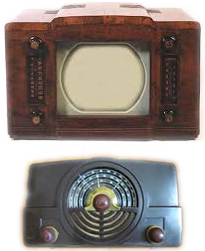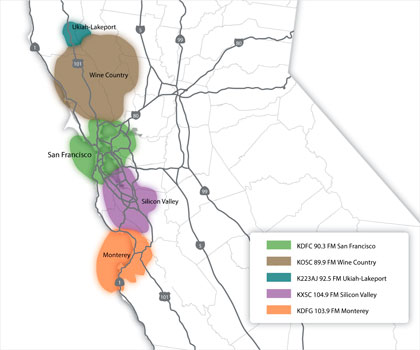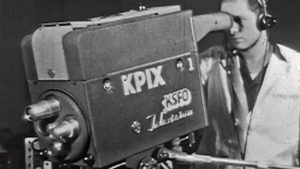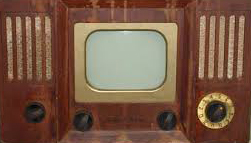 When a marriage turns 70 it’s called a platinum anniversary. When a broadcaster hits that mark, it’s a golden moment.
When a marriage turns 70 it’s called a platinum anniversary. When a broadcaster hits that mark, it’s a golden moment.
That’s what’s happening for two mainstays of the Bay Area airwaves: Classical FM radio station KDFC and television station KPIX are celebrating. Both stations launched in 1948, a time when FM radio and television were in their commercial infancy.
KDFC went live on Sept. 1, 1948, the first classical music station in the Bay Area. In its timeline, the station says it played music from 78 rpm records and was on the air from 3:30 to 10:30 p.m. The call letters derived from the last names of three employees: salesman Ed Davis, engineer Herbert Florance, and founder Bill Crocker.
The station’s modest beginnings were announced on Oct. 30, 1947, in the Sausalito News:
“Sausalito is soon to have an FM radio station! This was revealed yesterday by realtor W. Robert Miller who stated that negotiations have been in progress since June with a group of New York men who head the Sundial Broadcasting Corporation there. According to Miller, an acre of land atop Mt. Beacon above the highway was acquired from the Marin Land and Cattle Company, where the latest type FM tower will be built, towering 1200 feet above sea level. Miller stated that the firm had been granted a construction permit in September by the Federal Communications Commission. Proposed power of the station will be 30,000 watts on channel 271 with a frequency of 102.1 megacycles. The owners expect a coverage of about 80 miles radius. Major benefits of FM (frequency modulation) broadcasting are high fidelity, freedom from noise, static and interference.”

KDFC coverage map
Soon the station expanded its hours and began to rely on automated programming. A series of ownership changes led in 1997 to KDFC’s purchase by Bonneville International, which retained the classical format and offered popular hosts Bill Lueth, Dianne Nicolini, Rik Malone and, later, Hoyt Smith. By fall of 2000, the station says, it became the highest-rated music station in the Bay Area.
Classical radio was struggling, though, and in 2011, the station was purchased by the University of California and converted to a nonprofit. Its old spot on the FM dial – 102.1 MHz – became home to a rock format.
With a series of investments by USC, KDFC has upgraded its coverage and now broadcasts in much of Northern California with various call letters on 89.9, 90.3 92.5, 103.9 and 104.9. It also live streams on the Internet, connects through iOS and Android apps, and responds to commands to play on smart speakers.
The station’s pioneers had a vision for classical music’s place on the radio dial, according to Bill Crocker’s daughter, Chris Crocker.
“They wanted to do something that was new with classical music, and of course FM was very, very new then, and had sort of opened up what you could broadcast with classical music,” she told the station.
On Dec. 22, 1948, less than four months after KDFC’s launch, KPIX-TV took to the air on VHF Channel 5. Broadcasting from the top of the Mark Hopkins Hotel on Nob Hill, the station needed an audience, and that’s where the iconic retailer Sherman Clay and Co. came in. It was a symbiotic relationship: Sherman Clay, which sold pianos and sheet  music, added televisions to its inventory. KPIX, which had a signal but wanted viewers, started transmitting test patterns, allowing Sherman Clay to show customers the wonder of TV.
music, added televisions to its inventory. KPIX, which had a signal but wanted viewers, started transmitting test patterns, allowing Sherman Clay to show customers the wonder of TV.
When the first officially broadcast test pattern went on at 6:45 p.m. on Dec. 22, the stations says, about 600 TV sets had been sold. Fifteen minutes later, KPIX says, viewers watched the kids show “Howdy Doody.”
Programming over the years included live remotes, Edward R. Murrow’s first “See It Now” episode, and coverage of the first live coast-to-coast news event – President Harry Truman’s announcement from the San Francisco Opera House that World War II had officially ended.
By 1952 KPIX moved to up-to-date studios at Van Ness Avenue and Greenwich Street, the site of a hit afternoon show remembered still by viewers of a certain generation: Dick Stewart’s “Dance Party,” which ran in the late 1950s and early ‘60s and was the Bay Area version of Dick Clark’s “American Bandstand.”
Big band fans could sees stars such as Ella Fitzgerald and Johnny Mathis on Del Courtney’s variety show.
KPIX pioneered in other ways. The “Noon News,” Northern California’s first half-hour news show, featured John Weston and Wanda Ramey. The station hired Belva Davis, the first African-American woman to become a television reporter on the West Coast. Other on-air personalities were-near legends locally, among them Dave McElhatton, Van Amberg, Mike Sugerman, Wendy Tokuda and even Mutley, the canine partner of Doug McConnell on “Bay Area Backroads.”
The long road from the Mark Hopkins eventually took KPIX to its current home, 855 Battery St., a building once occupied by the American Biscuit Co., later to be known as Nabisco.

